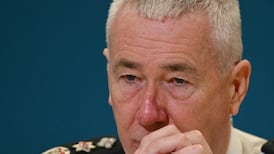A Garda dig for the remains of Dr Deirdre O'Flaherty in Donegal has concluded on the 10-year anniversary of her disappearance, with nothing of any significance found.
Dr O’Flaherty vanished on January 11th, 2009, in Co Donegal where she was staying with her husband and three children.
Three years later she was officially declared deceased by the High Court in Belfast after it said it was satisfied she had entered the sea from a beach and died.
Her remains have not been recovered despite a sea search off Kinnego Beach on the Inishowen peninsula where her car was found on the day she vanished.
However, the excavation carried out by gardaí for the past five days was at a site almost 70km (by road) from that beach. The search site is also across Drongawn Lough from the Inishowen peninsula.
The exact location of the excavation, which began on Monday, is on a wind farm between Rathmullan and Kerrykeel. The area is very remote bogland and popular with dog walkers.
A number of gardaí using a mini-digger were on site. Gardaí had initially considered using geothermal imaging in a bid to locate any body.
However, because of the rocky terrain, it was decided to scrape away layers of soil using a smaller digger.
The search was based on co-ordinates given in an anonymous letter from a member of the public claiming Dr O’Flaherty’s body was buried at that spot.
However, nothing was found and there is no evidence to challenge the accepted scenario that she entered the water 10 years ago off Kinnego Beach and died.
Dr O'Flaherty was originally from Belfast but had been working as a doctor in Strabane, Co Tyrone. She had also practised in Derry and Omagh under her maiden name Donnelly.
Her husband, Dr Ken O'Flaherty, has close ties to the Moville area of Donegal. His father had worked as a GP there.
His wife’s case was the first one concluded before the courts in the North under new laws at the time. The system allowed for people who were missing and presumed dead to be legally declared deceased under a streamlined process.
Before then, families were obliged to wait at least seven years until a missing loved one could be declared dead. But under the new system Dr O’Flaherty’s family secured a declaration after three years.
Dr O’Flaherty’s disappearance was a suspected suicide from the outset, and because of that the case did not generate significant media coverage at the time.
She had suffered from depression and had been taking medication for it. That background, combined with the circumstances of her disappearance, meant the case was always regarded as a suicide.
Dr O'Flaherty's silver BMW SUV, with the keys in the ignition, was found on the beach by a walker. Her sandals were found in the footwell of the car, and her doctor's bag was also in the vehicle.
She had also left her rings at the nearby house her family owned, along with her mobile phone.
In 2012, when the legal process for declaring her deceased was before the Belfast High Court, the judge was told she had left notes for her three children saying: "I will always love you xx Mum".
Her bank cards were not used after her disappearance, and her bank accounts remained untouched.
Although the Garda dig at a piece of land some 70km away flew in the face of her assumed suicide at sea, the Garda said throughout the past week that the status of the case was unchanged and remained a missing persons inquiry.
When the dig concluded yesterday with nothing found, Garda sources said officers in Donegal had felt duty bound to carry out the excavations.
“When new information emerges, you feel you have to act on it,” said one source.
“If you don’t, there will always be a question mark about whether you missed a breakthrough in a case because you did nothing.”
Gardaí have in recent years carried out searches and excavations as part of their investigations into other historical missing persons’ cases because new information has emerged.
In those cases, although the Garda felt obliged to act on the new information, no breakthroughs were achieved.
In some instances – especially in the case of Trevor Deely, who went missing in Dublin just over 18 years ago after leaving an office Christmas party – gardaí believe the new information has effectively solved the mystery.
Detectives believe Mr Deely was shot by a criminal early in the morning in Dublin city and his remains dumped to conceal the crime.
However, his remains have not been recovered despite extensive searching in Chapelizod, Co Dublin, in 2017.
In other cases, specific information supplied about the location of human remains has been tested with excavation and searching and has yielded nothing.
Searches based on apparently new information have been done down the years as part of the inquiries into the disappearances of Fiona Sinnott, Fiona Pender, Deirdre Jacob and others.










